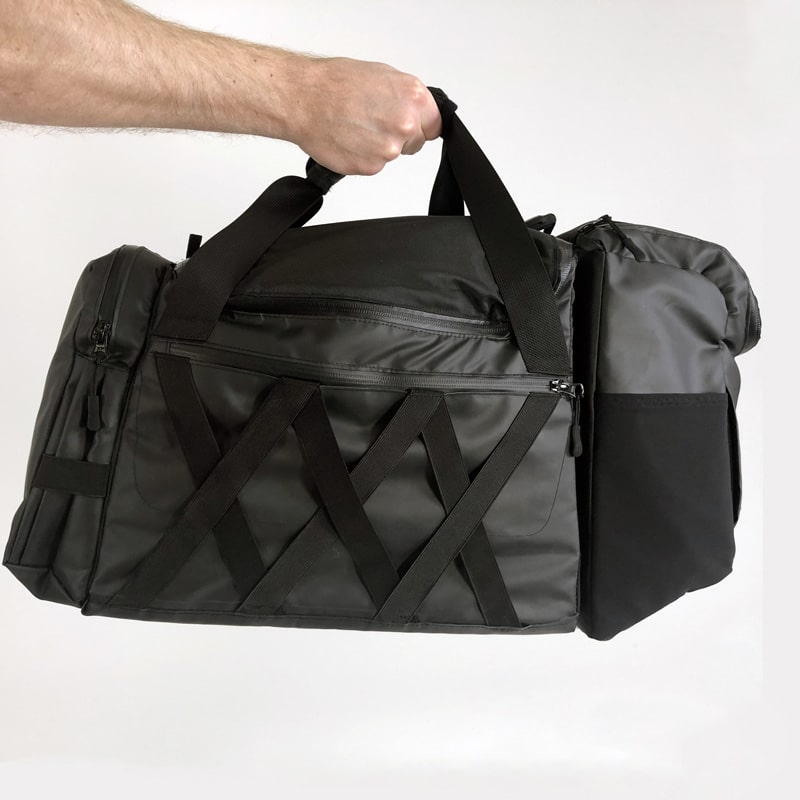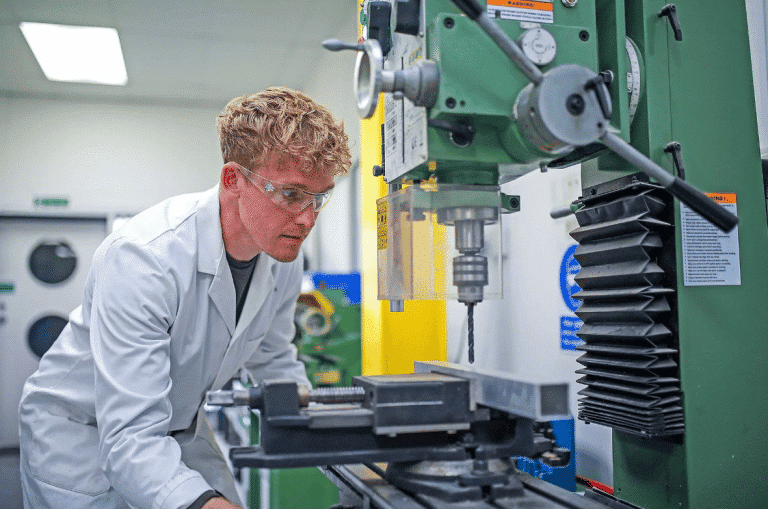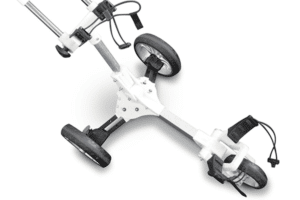Proof of Principle Prototype

Introducing D2M’s Proof of Principle Prototyping: an innovative, cost-effective approach to product development that focuses on testing and validating the core functionalities of your innovation. This service ensures that your product’s fundamental mechanisms and ergonomics are sound, saving you time and resources before investing in full-scale prototypes.
Our Process
Concept Validation
The journey begins with concept validation, a step that lays the groundwork for the entire prototyping process. Initially, the focus is on understanding the product’s core functionality and purpose. This involves scrutinising the basic mechanics or features crucial to the product’s success.
For example, in the proving oven project, the essential task was establishing the oven’s ability to maintain a consistent temperature, which is critical for efficient dough proving. Similarly, for the pushchair prototype, the primary concern was testing the impact of various wheel sizes on the pushchair’s overall usability and performance.
This step is not about delving into complex designs but ensuring that the fundamental concept holds potential and is worth pursuing.
Creation and Testing
Following the initial validation, the process advances to creating and testing a basic, functional prototype. Unlike detailed prototypes, these are constructed using readily available materials or by adapting existing products to suit the specific testing needs. The essence here is to craft a prototype that embodies the core concept and can undergo practical, real-world testing.
For the proving oven, this meant building a rudimentary oven structure to experiment with different heating elements and assess heat loss and distribution. In the case of the pushchair, a second-hand pushchair was modified, experimenting with various axle attachments and wheel sizes.
This step is crucial as it offers the first tangible glimpse of the product in action, allowing for an assessment of its functionality and unveiling any unforeseen design challenges or opportunities.
Analysis and Iterative Refinement
The final step is where the prototype undergoes rigorous analysis and iterative refinement. This step is pivotal in transforming the initial model into a refined prototype that closely aligns with the envisioned product in the next stage.
The insights from the testing phase are invaluable, often leading to significant modifications or enhancements. In the proving oven example, the tests led to changes in the heating element size and adjustments to the door design for enhanced heat retention. For the pushchair, the feedback from wheel size testing was instrumental in refining the axle design and improving the ergonomics and handling.
This step is an iterative loop of testing, feedback, and refinement, ensuring that each aspect of the prototype is meticulously polished and aligned with the product’s intended functionality and market needs.
To summarise, each step in the Proof of Principle Prototyping process is integral to transforming a concept into a functional and feasible prototype. This journey is about building a model that mirrors the initial idea and discovering and addressing the nuances that could impact the final product’s design and functionality.
By ensuring that each prototype iteration is cost-effective and rich in practical insights, this process lays a solid foundation for the subsequent, more detailed stages of product development. The proving oven and pushchair projects exemplify how this process can lead to prototypes that are not just prototypes in name but robust representations of a product’s future in the market.
Rapid Validation of Core Concepts
Proof of Principle Prototyping excels in rapidly validating a product’s fundamental concepts. This benefit is paramount in the early stages of product development, where time is a critical factor. The process is designed to test and confirm the viability of core ideas quickly and efficiently without the need for extensive resources or elaborate assembly setups. This rapid validation means that businesses and innovators can swiftly determine whether their concept has the potential to succeed in the real world or if it requires rethinking.
This rapid validation is seen in projects like the proving oven and pushchair examples. The core concept of maintaining a specific temperature for adequate dough proving was tested expeditiously for the proving oven. Similarly, the idea of interchangeable wheel sizes was quickly validated for the pushchair, providing essential insights into the product’s ergonomics and usability. This swift concept validation is crucial for maintaining momentum in the development process and ensures that ideas can be tested, iterated, and refined without significant delays.

Cost and Time Efficiency
One of the most significant advantages of Proof of Principle Prototyping is the substantial savings in both cost and time compared to full-scale prototyping. Developing a full-scale prototype can be expensive and time-consuming, involving detailed design work, costly materials, and often complex manufacturing processes. Time and money can be wasted creating the whole assembly, only to find the whole assembly needs to be changed later to accommodate a modified element which isn’t working as it is required to. In contrast, Proof of Principle Prototyping focuses on the core elements of the product, using more straightforward and cost-effective methods and materials.
For instance, in the pushchair project, rather than constructing an entirely new prototype from scratch, an existing pushchair was modified to test different wheel sizes. This approach significantly reduced the costs and time involved in the development process. Similarly, the proving oven project utilised a basic construction to test the fundamental concept of the product, avoiding the high costs associated with designing and manufacturing a complete oven prototype. This efficiency in both time and resources is invaluable, particularly for startups and small businesses with limited budgets.


Adaptability and Flexibility
The adaptability and flexibility offered by Proof of Principle Prototyping are unmatched. The process inherently allows for easy and quick modifications based on the outcomes of the testing phase. This flexibility is crucial in the dynamic landscape of product development, where changes and refinements are often needed to meet user requirements or to adapt to new findings.
The proving oven project illustrates this flexibility well. Based on the initial testing results, adjustments were made to the size of the heating element and the oven’s door design. These changes were implemented quickly and applied to the rest of the assembly without significant additional costs. Similarly, the pushchair project demonstrated adaptability in its design, allowing various wheel sizes to be tested and the axle attachments to be modified as needed. This level of adaptability ensures that the prototyping process is not rigid but evolves with the project’s needs, ultimately leading to a more refined and successful final product.
Proof of Principle Prototyping provides a streamlined, cost-effective, and flexible approach to product development. Its ability to rapidly validate concepts, save significant time and resources, and adapt to changing requirements makes it an essential process for any innovator looking to bring a new product to market efficiently and effectively.

FAQs
What is a "proof of principle" prototype?
A “proof of principle” prototype is a preliminary product version constructed to test and validate the core functionalities and concepts. This type of prototype focuses specifically on the fundamental aspects of the product, such as its mechanics, ergonomics, and essential design elements. It is less about aesthetics and more about practicality and functionality. The purpose of such a prototype is to ensure that the critical element of a product work as intended in a real-world setting before investing in developing the rest of the assembly in more detailed and expensive prototypes.
How does a "proof of principle" prototype differ from other types of prototypes?
Proof of principle prototypes differ from other prototypes in their scope and purpose. While most prototypes are designed to be close representations of the final product in terms of appearance, functionality, and materials used, proof of principle prototypes are more rudimentary. They are typically constructed using simpler and more cost-effective methods and materials, focusing solely on the essential functional elements of the product. They do not encompass the complete assembly or features of the intended final product, as is often the case with more advanced prototypes like functional or presentation prototypes.
What are the main objectives of creating a proof of principle prototype?
The main objectives of creating a proof of principle prototype include:
- Validation of Core Concepts: To test and confirm that the fundamental idea behind the product is viable and functions as intended.
- Identification of Design Flaws: To uncover any potential flaws or issues in the basic design before proceeding to more complex and costly stages of development.
- Cost and Time Efficiency: To save on the time and expenses incurred in creating full-scale prototypes for concepts that still need to be proven.
- Guiding Further Development: To provide valuable insights and data that inform and guide the subsequent product design and development stages.
When in the product development process should a proof of principle prototype be developed?
Creating a proof of principle prototype before developing more detailed prototypes is crucial for several reasons:
- Risk Mitigation: It minimises the risk of investing heavily in a concept yet to be tested for basic functionality and feasibility. Time and money can be wasted creating the whole assembly, only to find the whole assembly needs to be changed later to accommodate a necessary modification to an element which isn’t working as it is required to.
- Resource Optimisation: It helps optimise resources by ensuring that time, effort, and money are invested in concepts proven to work on a fundamental level.
- Iterative Design: It allows for an iterative design approach, where feedback from the proof of principle prototype can be used to make informed improvements in subsequent prototypes.
- Stakeholder Confidence: It builds confidence among stakeholders and investors, as they can see a tangible demonstration of the product concept and its potential.
Why create a "proof of principle" prototype before going onto build "proper" prototypes?
Creating a proof of principle prototype before developing more detailed prototypes is crucial for several reasons:
- Risk Mitigation: It minimises the risk of investing heavily in a concept yet to be tested for basic functionality and feasibility. Time and money can be wasted creating the whole assembly, only to find the whole assembly needs to be changed later to accommodate a necessary modification to an element which isn’t working as it is required to.
- Resource Optimisation: It helps optimise resources by ensuring that time, effort, and money are invested in concepts proven to work on a fundamental level.
- Iterative Design: It allows for an iterative design approach, where feedback from the proof of principle prototype can be used to make informed improvements in subsequent prototypes.
- Stakeholder Confidence: It builds confidence among stakeholders and investors, as they can see a tangible demonstration of the product concept and its potential.
Overview of Proof of Principle Prototype
This approach primarily tests fundamental elements of a product – from ergonomics and structural integrity to basic functionality – before committing to the expense and effort of a full assembly in full-scale prototyping. It’s an invaluable process for confirming the feasibility of your concept in a real-world scenario.
Why Choose This Service?
- Cost-Effective Validation: This method offers a significant cost advantage. Focusing on the essential features of a product reduces the expenditure associated with creating detailed prototypes.
- Practical Insight: Unlike theoretical analysis, this approach provides valuable insights into how different elements of a product work together. You learn firsthand the nuances that could impact the product’s final design and functionality.
- Risk Mitigation: Early detection of potential design issues or shortcomings helps mitigate risks before advancing to more costly development stages.
- Accelerated Learning Curve: This rapid prototyping process accelerates the learning curve, allowing for swift modifications based on tangible feedback.
The practicality and effectiveness of Proof of Principle Prototyping are best illustrated through two key projects we’ve undertaken:
- The Pushchair Project: In this case, the primary challenge was to test different wheel sizes on a pushchair without constructing an entire prototype. By acquiring a similar second-hand pushchair and experimenting with various wheel sizes, we were able to test factors like seat angle and handling efficiently. This approach saved significant costs and provided critical insights into the pushchair’s overall design and user experience.
- The Proving Oven Concept: The goal was to create an oven that could accelerate the proving of bread. The Proof of Principle Prototype allowed us to test different heating elements and understand heat loss dynamics. The prototype was built rapidly and cost-effectively, providing practical insights that calculations alone couldn’t offer. We learned about the optimal size of the heating element, the oven’s capacity to accommodate different mixing bowls and necessary adjustments to the door design for maintaining heat efficiency.
These examples underscore how Proof of Principle Prototyping goes beyond mere concept validation. It offers a hands-on, cost-effective approach to refining a product idea, confirming its practicality and potential success before proceeding to more elaborate prototyping stages.
By choosing our Proof of Principle Prototyping service, you’re not only opting for an economical pathway to validate your concept but also engaging in a process that provides crucial learnings and paves the way for a more informed and refined product development journey. Whether adapting a pushchair to diverse terrains or ensuring a home oven meets the baker’s needs, this service brings your innovative ideas closer to reality with practicality and precision.
Embarking on Proof of Principle Prototyping is a critical step in product development, especially for innovators eager to transform abstract ideas into concrete, functioning models. This exhaustive three-step process is designed to meticulously validate, test, and refine a product’s fundamental aspects, ensuring that the initial concept is viable and primed for further development.